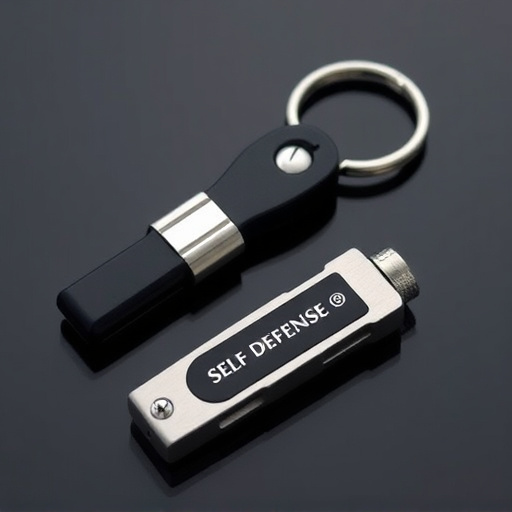University Approved Safety Keychains combine tactical effectiveness with user-friendly features, adhering to stringent campus security standards. They feature durable materials like steel and reinforced nylon, built-in tools (screwdrivers, glass breakers, flashlights), secure lock mechanisms, slip-resistant grips, and ergonomic designs for easy carrying. These keychains prioritize safety through rigorous testing, non-toxic materials, ANSI/NSFI compliance, and advanced polymer integration. Training exercises focus on hand-eye coordination, reflex response time, control, and diverse grip techniques to ensure reliable self-defense in critical situations.
“Enhance your personal safety with the innovative concept of self-defense keyrings. In this article, we explore the tactical grip design behind these compact tools, highlighting their potential as a University-approved safety measure. From understanding the principles of effective design to the crucial role of advanced materials and practical training, we dissect what makes these keychains indispensable. Discover why ‘University Approved Safety Keychains’ are becoming a staple for personal defense.”
- Understanding Tactical Keychain Design
- University Approval Criteria for Safety
- Keyring Grip: Essential Features
- Advanced Materials for Durability
- Training and Drills for Effective Use
Understanding Tactical Keychain Design
Tactical keychain designs have evolved far beyond simple functionality, integrating advanced features for enhanced safety and protection. Beyond a standard hang-keychain, tactical models often incorporate durable construction materials like high-strength steel and reinforced nylon webbing. These keychains may also feature built-in tools such as small screwdrivers, glass breakers, or flashlights—essential components for self-defense situations that can be discretely carried on your keys.
University Approved Safety Keychains highlight this trend, prioritizing not only reliability but also regulatory compliance. Designed with input from law enforcement and safety experts, these keychains offer a blend of tactical effectiveness and user-friendly features, ensuring individuals have access to essential tools when needed most—all while adhering to campus security standards.
University Approval Criteria for Safety
University approval criteria for safety keyring tactical grip designs are stringent, reflecting the heightened security concerns on campus. These criteria often include rigorous testing for sharp edge retention and the ability to withstand various stress tests, ensuring the keychain doesn’t fail under pressure. The materials used must be non-toxic and durable, preventing any potential harm or damage to both users and property.
In terms of University Approved Safety Keychains, features like a secure lock mechanism, slip-resistant grip, and a design that allows for easy carrying and quick access are highly valued. Compliance with industry standards such as ANSI/NSFI (National Safety Foundation International) ensures the product meets or exceeds safety expectations. This rigorous vetting process guarantees students, faculty, and staff have access to reliable self-defense tools while adhering to the highest safety standards set by educational institutions.
Keyring Grip: Essential Features
A keyring grip is an integral part of any self-defense tactical keychain, offering users a secure and comfortable hold. When choosing a university-approved safety keychain, look for key features such as ergonomic design and non-slip surfaces. These ensure a firm grasp, allowing you to easily deploy the tool when needed without dropping it. The grip should also be lightweight yet durable, made from high-quality materials that can withstand daily use and potential impact.
Additionally, consider the inclusion of a safety lock mechanism or a secure clamping system. These features prevent accidental deployment and ensure the keychain remains attached to your keyring until you actively need it for self-defense purposes. Such tactical grips are designed to provide peace of mind, knowing that your personal safety tool is readily available yet securely stored when not in use.
Advanced Materials for Durability
In the realm of self-defense tools, keyrings have evolved beyond their traditional function, incorporating advanced materials and tactical designs. One notable innovation is the use of university-approved safety materials, ensuring both durability and reliability in critical situations. These keychains are crafted from high-strength alloys, such as stainless steel, known for its resistance to corrosion and impact, making them suitable for tactical applications.
The integration of advanced polymers further enhances their performance. These materials offer exceptional grip and comfort, allowing users to wield the keychain with precision and control. Moreover, certain models incorporate non-slip textures, ensuring a secure grasp even in challenging environments. Such strategic design choices not only contribute to the overall durability but also cater to the practical needs of individuals seeking effective self-defense solutions.
Training and Drills for Effective Use
Training and drills are essential components in mastering the effective use of a self-defense keyring with a tactical grip design, especially if you want to ensure its safety and reliability in real-world scenarios. University-approved safety keychain programs often incorporate a range of exercises tailored to improve hand-eye coordination, reflex response time, and overall control. These drills may include target practice at various distances and angles, simulating self-defense situations such as disarming an attacker or blocking blows.
Regular training sessions should also focus on different grip techniques suitable for diverse environments and physical engagements. Practicing with a partner can greatly enhance learning outcomes by providing the opportunity to experience live feedback and refine movements under pressure. Such exercises not only improve individual skills but also foster teamwork, making it an invaluable asset in group safety initiatives.
In conclusion, a well-designed tactical keychain with a robust grip can be a valuable tool for self-defense. By understanding the key features, materials, and training methods outlined in this article—including University-approved safety criteria—individuals can make informed choices to enhance their personal security. Investing in high-quality, durable keychains equipped with advanced grips is a proactive step towards staying safe in various environments.
